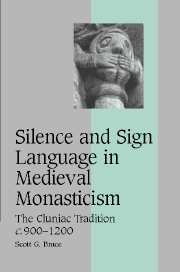Book contents
- Frontmatter
- Contents
- List of tables
- Acknowledgments
- List of abbreviations
- Map
- INTRODUCTION: THE DORMANT LANGUAGE
- 1 UTTERING NO HUMAN SOUND
- 2 THE TRAINING OF THE HAND
- 3 A SILENT COMMERCE OF SIGNS
- 4 TRANSMISSION AND ADAPTATION
- 5 CONTINUITY AND CRITICISM
- CONCLUSION
- Appendix A: The Cluniac sign lexicon
- Bibliography
- Index
- Cambridge Studies in Medieval Life and Thought Fourth Series
3 - A SILENT COMMERCE OF SIGNS
Published online by Cambridge University Press: 16 July 2009
- Frontmatter
- Contents
- List of tables
- Acknowledgments
- List of abbreviations
- Map
- INTRODUCTION: THE DORMANT LANGUAGE
- 1 UTTERING NO HUMAN SOUND
- 2 THE TRAINING OF THE HAND
- 3 A SILENT COMMERCE OF SIGNS
- 4 TRANSMISSION AND ADAPTATION
- 5 CONTINUITY AND CRITICISM
- CONCLUSION
- Appendix A: The Cluniac sign lexicon
- Bibliography
- Index
- Cambridge Studies in Medieval Life and Thought Fourth Series
Summary
On a winter night in the early twelfth century, the monks of Cluny awoke to the sound of screaming so persistent that it eventually roused the entire community. A novice named Armannus was raving in his sleep and no effort could wake him from his terrible dream. The alarmed monks rushed to the bedside of their abbot, but the lateness of the hour prohibited them from speaking, so they made it known to him with signs (nutibus) that something extraordinary was taking place. As it turned out, the novice had been terrified by a vision of the devil in the form of a ravenous bear. Peter the Venerable related this episode in his treatise On Miracles, but unlike John of Salerno, whose expository digression 200 years earlier in the tenth-century Life of Odo provided the earliest description of the character and function of the Cluniac sign language, the abbot felt no need to explain or otherwise qualify the actions of his brethren. By the time of his abbacy (1122–1156), the custom of using signs in place of spoken words was woven so tightly into the fabric of monastic life at Cluny that knowledge of it was easily taken for granted by those who employed it. In fact, cloistered authors rarely mentioned the use of sign language at all.
Surprisingly little is known about the practical applications of monastic sign language at Cluny. Most studies have relied heavily on the Cluniac sign lexicon for information about this custom.
- Type
- Chapter
- Information
- Silence and Sign Language in Medieval MonasticismThe Cluniac Tradition, c.900–1200, pp. 77 - 97Publisher: Cambridge University PressPrint publication year: 2007

